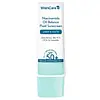What's inside
What's inside
 Key Ingredients
Key Ingredients

 Benefits
Benefits

 Concerns
Concerns

 Ingredients Side-by-side
Ingredients Side-by-side

Water
Skin ConditioningEthylhexyl Methoxycinnamate
UV AbsorberDiethylamino Hydroxybenzoyl Hexyl Benzoate
UV FilterDimethicone
EmollientEthoxydiglycol
HumectantMethylene Bis-Benzotriazolyl Tetramethylbutylphenol
UV FilterPropylene Glycol Dicaprylate/Dicaprate
EmollientDiisopropyl Sebacate
EmollientDiisopropyl Adipate
EmollientC12-15 Alkyl Benzoate
AntimicrobialButylene Glycol
HumectantPhenoxyethanol
PreservativeVp/Eicosene Copolymer
Isododecane
EmollientPentylene Glycol
Skin ConditioningPotassium Cetyl Phosphate
EmulsifyingAcrylates/Polytrimethylsiloxymethacrylate Copolymer
Skin ConditioningDecyl Glucoside
CleansingTriethanolamine
BufferingCarbomer
Emulsion StabilisingAcrylates/C10-30 Alkyl Acrylate Crosspolymer
Emulsion StabilisingPolyacrylate Crosspolymer-6
Emulsion StabilisingEthylhexylglycerin
Skin ConditioningTrisodium Ethylenediamine Disuccinate
Propylene Glycol
HumectantCyclopentasiloxane
EmollientDimethicone Crosspolymer
Emulsion StabilisingCaprylyl Methicone
Skin ConditioningPEG-12 Dimethicone/PPG-20 Crosspolymer
Polymethylsilsesquioxane
Xanthan Gum
EmulsifyingWater, Ethylhexyl Methoxycinnamate, Diethylamino Hydroxybenzoyl Hexyl Benzoate, Dimethicone, Ethoxydiglycol, Methylene Bis-Benzotriazolyl Tetramethylbutylphenol, Propylene Glycol Dicaprylate/Dicaprate, Diisopropyl Sebacate, Diisopropyl Adipate, C12-15 Alkyl Benzoate, Butylene Glycol, Phenoxyethanol, Vp/Eicosene Copolymer, Isododecane, Pentylene Glycol, Potassium Cetyl Phosphate, Acrylates/Polytrimethylsiloxymethacrylate Copolymer, Decyl Glucoside, Triethanolamine, Carbomer, Acrylates/C10-30 Alkyl Acrylate Crosspolymer, Polyacrylate Crosspolymer-6, Ethylhexylglycerin, Trisodium Ethylenediamine Disuccinate, Propylene Glycol, Cyclopentasiloxane, Dimethicone Crosspolymer, Caprylyl Methicone, PEG-12 Dimethicone/PPG-20 Crosspolymer, Polymethylsilsesquioxane, Xanthan Gum
Water
Skin ConditioningCyclopentasiloxane
EmollientEthylhexyl Salicylate
UV AbsorberNiacinamide
SmoothingSilica
AbrasiveButyl Methoxydibenzoylmethane
UV AbsorberOctocrylene
UV AbsorberButylene Glycol
HumectantGlycerin
HumectantHomosalate
Skin ConditioningTapioca Starch
Neopentyl Glycol Diheptanoate
EmollientAmps/Hema Crosspolymer
C13-15 Alkane
SolventCoco-Glucoside
CleansingOctyldodecanol
EmollientPolysorbate 20
EmulsifyingZinc Oxide
Cosmetic ColorantTitanium Dioxide
Cosmetic ColorantAvena Sativa Kernel Extract
AbrasiveZinc PCA
HumectantSorbitan Olivate
EmulsifyingCeramide AP
Skin ConditioningCeramide NP
Skin ConditioningCeramide Eos
Skin ConditioningPanthenol
Skin ConditioningCentella Asiatica Extract
CleansingEthylhexylglycerin
Skin ConditioningPhenoxyethanol
PreservativeXanthan Gum
EmulsifyingTocopheryl Acetate
AntioxidantHyaluronic Acid
HumectantCitric Acid
BufferingWater, Cyclopentasiloxane, Ethylhexyl Salicylate, Niacinamide, Silica, Butyl Methoxydibenzoylmethane, Octocrylene, Butylene Glycol, Glycerin, Homosalate, Tapioca Starch, Neopentyl Glycol Diheptanoate, Amps/Hema Crosspolymer, C13-15 Alkane, Coco-Glucoside, Octyldodecanol, Polysorbate 20, Zinc Oxide, Titanium Dioxide, Avena Sativa Kernel Extract, Zinc PCA, Sorbitan Olivate, Ceramide AP, Ceramide NP, Ceramide Eos, Panthenol, Centella Asiatica Extract, Ethylhexylglycerin, Phenoxyethanol, Xanthan Gum, Tocopheryl Acetate, Hyaluronic Acid, Citric Acid
 Reviews
Reviews

Ingredients Explained
These ingredients are found in both products.
Ingredients higher up in an ingredient list are typically present in a larger amount.
Butylene Glycol (or BG) is used within cosmetic products for a few different reasons:
Overall, Butylene Glycol is a safe and well-rounded ingredient that works well with other ingredients.
Though this ingredient works well with most skin types, some people with sensitive skin may experience a reaction such as allergic rashes, closed comedones, or itchiness.
Learn more about Butylene GlycolCyclopentasiloxane, or D5, is a silicone used to improve texture of products and trap moisture.
D5 is considered lightweight and volatile. Volatile means it evaporates quickly after application. Once evaporated, D5 leaves a thin barrier that helps keep skin hydrated.
It is also an emollient. Emollients help soften the skin and prevent water loss. Silicones create a silky texture in products. D5 helps other ingredients become more spreadable.
Studies show D5 is safe to use in skincare products. We recommend speaking with a skincare professional if you have concerns.
Learn more about CyclopentasiloxaneEthylhexylglycerin (we can't pronounce this either) is commonly used as a preservative and skin softener. It is derived from glyceryl.
You might see Ethylhexylglycerin often paired with other preservatives such as phenoxyethanol. Ethylhexylglycerin has been found to increase the effectiveness of these other preservatives.
Phenoxyethanol is a preservative that has germicide, antimicrobial, and aromatic properties. Studies show that phenoxyethanol can prevent microbial growth. By itself, it has a scent that is similar to that of a rose.
It's often used in formulations along with Caprylyl Glycol to preserve the shelf life of products.
Water. It's the most common cosmetic ingredient of all. You'll usually see it at the top of ingredient lists, meaning that it makes up the largest part of the product.
So why is it so popular? Water most often acts as a solvent - this means that it helps dissolve other ingredients into the formulation.
You'll also recognize water as that liquid we all need to stay alive. If you see this, drink a glass of water. Stay hydrated!
Learn more about WaterXanthan gum is used as a stabilizer and thickener within cosmetic products. It helps give products a sticky, thick feeling - preventing them from being too runny.
On the technical side of things, xanthan gum is a polysaccharide - a combination consisting of multiple sugar molecules bonded together.
Xanthan gum is a pretty common and great ingredient. It is a natural, non-toxic, non-irritating ingredient that is also commonly used in food products.
Learn more about Xanthan Gum